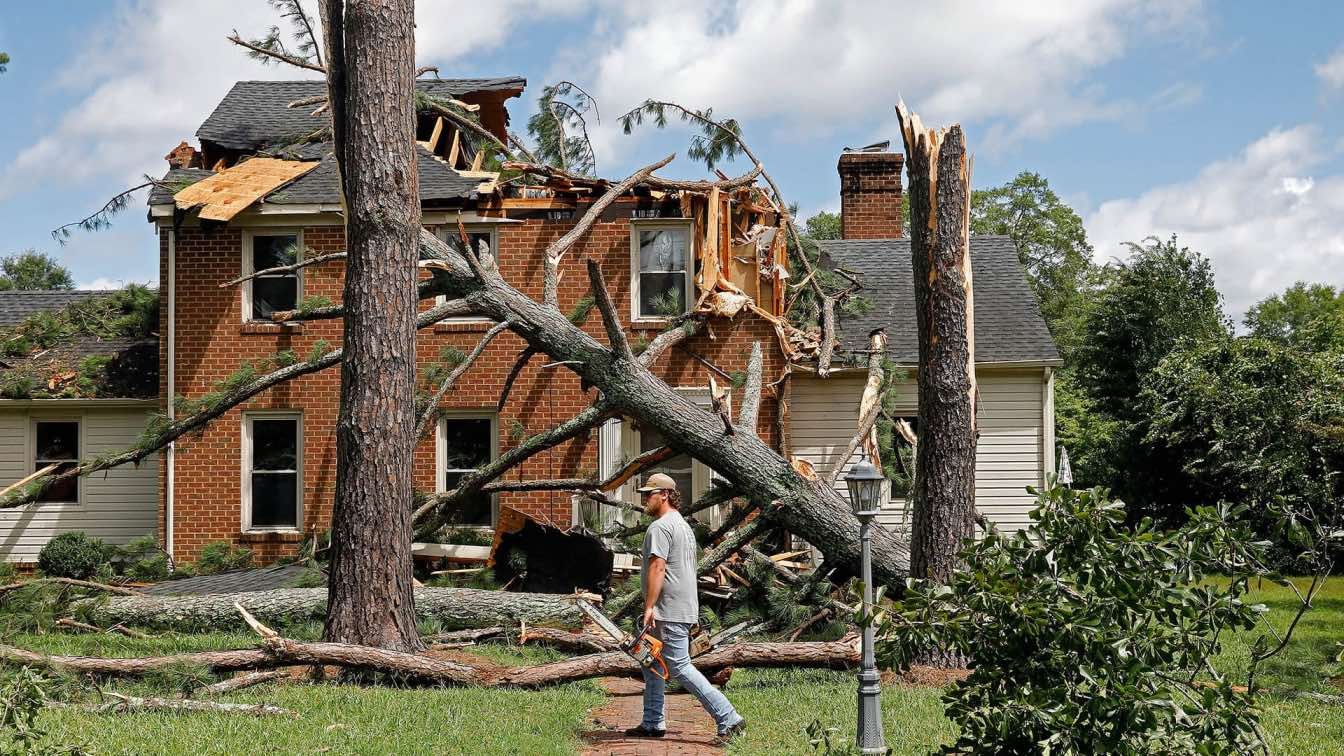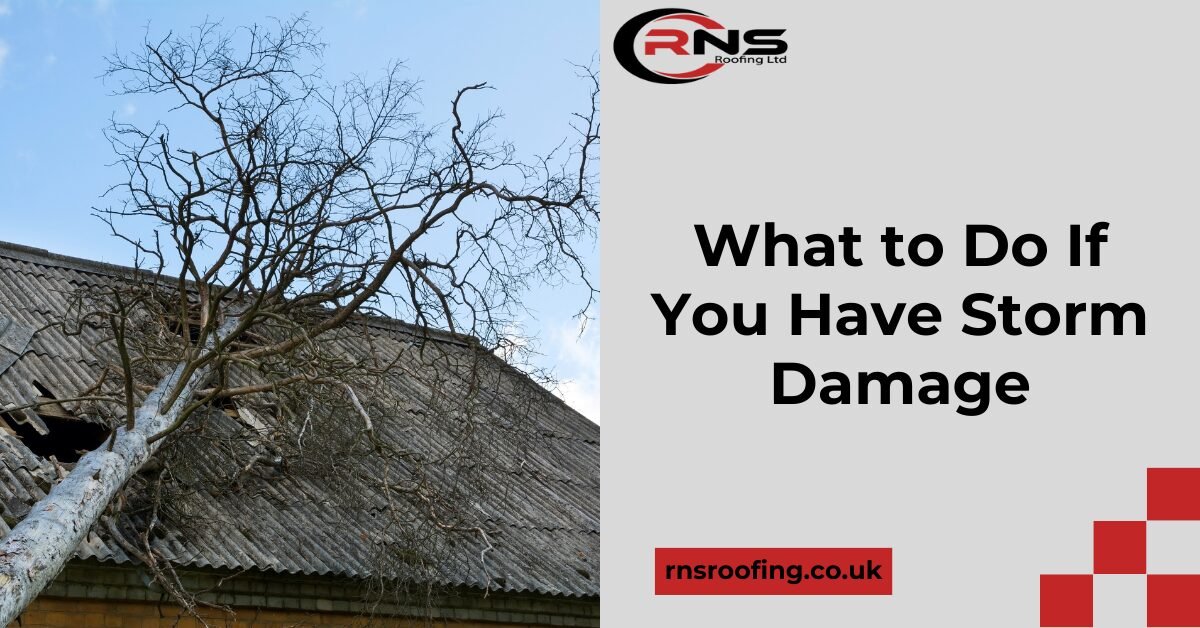A recently installed roof shouldn’t have stood up to bad weather. However, Mother Nature occasionally has different ideas. Do not panic if you discover storm-damaged roofs! Even if it could be annoying, it’s important to stay calm and take the appropriate action to get things back on track. Everything you need to know about handling storm damage to roofs will be covered in this article, from inspecting the damage to figuring out repairs and handling insurance claims.
It’s important to take action to protect your property as much as you can. This guide explains how to fix a roof and what to do if you have storm damage roofing issues don’t go away.
4 Kinds of Roofs Storm Damage:
Some kinds of roof storm damage are immediately apparent during a powerful storm. Then other kinds need further investigation, but that doesn’t mean they aren’t equally harmful. Here are some types of storm damage to roofs to be aware of.
1. Fallen Trees of other Debris:
Large storms have the potential to cause significant damage because they can drop trees, limbs, or other debris straight onto your roof, leaving huge gaps. This is the most obvious kind of storm damage to roofs and frequently needs the most extensive repairs.
2. Torn, Denied, or Missing Shingles:
If the primary roofing material on your house is shingles, you might observe some damage to them during a strong storm. Here are some things to be aware of:
- Torn shingles are usually a result of high winds ripping them in two.
- Dented shingles are typically a result of hail damage and might resemble black patches. You may also find loose shingle granules in your gutters.
- Missing shingles are shingles that have been completely removed from your roof.
3. Dented Gutters:
Gutters are designed to divert rainwater away from your house, but they aren’t always very resilient to strong storms. They may get dented, bent, or broken by hail and severe wind damage to the roof, rendering them useless until they are fixed.
4. Leaks:
There will be an exposed area of your roof that is at risk of leaks if a storm causes any holes or shingle loss. Look for any drips or indications of water damage in your attic and ceilings.

What to do when your roof is damaged by a storm:
After storm damage to your roof, the actions you take can significantly impact what happens next. Everything in your house, including the walls, floors, furniture, and other assets, is exposed to storm damage. To stop additional water damage, it is vital to return everything to normal as soon as possible, regardless of the extent of the damage. These are the steps to follow after the storm damage.
Step 1: Assess the Damage Safely
Safety First:
Make sure it’s safe to climb onto your roof before you do so. Hold off until the storm has gone entirely and the weather is calm. Leave climbing to the experts if you feel uncomfortable or if you suspect serious damage.
Ground Inspection:
Examine your roof from the ground level first. Examine any apparent holes or dents in metal roofs, broken or missing tiles, or missing shingles. Look for any stray debris from your roof that may be lying around your home.
Interior Inspection:
Go inside and check for leaks by looking for things like drips near windows, moisture in attics, or water stains on walls or ceilings. Keep in mind that minor leakage can cause big problems, so take quick action.
Documentation:
Record all the damage you see, both indoors and outside, using pictures and videos. These will be vital when sending an insurance claim or contacting a roofing contractor.
Step 2: Understanding Repair Options
The extent of the damage will determine your repair options. Here’s a breakdown:
Minor Damage:
Replacing each missing or cracked shingle separately may be adequate if the damage is limited to just a few of them. Usually, this is an easy and affordable repair.
Moderate Damage:
If larger sections of your roof are affected then it may require a more extensive repair, such as multiple missing shingles or a damaged metal panel. This may involve swapping out broken shingles for new waterproofing membranes or underlayment portions.
Major Damage:
If the storm damaged large portions of it or compromised its structural integrity then maybe the best course of action is storm damage roof replacement. This is especially true if your new roof was nearing the end of its expected lifespan anyway.
Newly Installed Roof Considerations:
While your roof may be completely new, keep in mind that warranties usually only cover flaws in production and not storm damage. However, extra coverage for specific events like hail or windstorms may be provided by certain warranties. Examine your warranty documentation carefully.
Step 3: Contacting Your Insurance Company
Making an insurance claim can reduce the expense of roofing storm damage repair. What you should know is as follows:
Filing the Claim:
As soon as possible after the storm, get in touch with your insurance provider and describe the damage you have noticed. Be ready to share information such as the storm’s date, pictures and videos of the damage, and the materials and date of installation of your roof.
Adjuster Visit:
An insurance adjuster will come to your house to evaluate the harm and estimate the cost of repairs. Cooperate with their inspection and provide honest answers to their questions.
Claim Decision:
Your insurance provider will decide whether to approve your claim and how much it will cost based on the adjuster’s report. Check the information carefully, and if there are any questions, feel free to ask.
Negotiation:
You can negotiate with your insurance provider if you don’t agree with the claim amount. Your case may be enhanced if you have estimates from licensed roofing contractors and recorded proof of the damage.
Step 4: Selecting a Qualified Roofing Contractor
Choosing the best contractor is important for ensuring correct repairs and optimizing your insurance payout. Here are some guidance:
Get Multiple Estimates:
Get estimates from a minimum of three trustworthy roofers who are knowledgeable about the kind and composition of your roof. Check their suggested fixes, resources, schedules, and guarantees.
Check Credentials:
Make sure the contractors have a clean record with previous customers, insurance, and a license. Inquire about their experience with repairing storm damage to your particular type of roof.
Communication is Key:
Select a contractor who is open and honest, will promptly respond to your inquiries, and will explain the materials and repair procedure in detail. Never be afraid to leave if something doesn’t seem right.
Contractual Agreement:
Make sure you have a legal agreement that outlines the work to be done, products to be used, warranties to be issued when payments are due, and how to coordinate insurance claims before any work starts.
Step 5: Repair and Recovery
The repair procedure can start as soon as you pick a contractor. Keep yourself updated on the development and feel free to voice any worries you may have. Make sure everything is done to your satisfaction by thoroughly inspecting the job when the repairs are finished.
Conclusion:
Although storm damage to your newly installed roof can be worrisome, you can efficiently fix it with the correct information and swift action. You can restore the integrity of your roof and shield your house from additional damage by checking for damage on your roof, determining the type of damage, and putting the right repair solutions in place. Never put anything less than safety first while fixing a roof, and if there is significant damage or repairs you are not skilled at, think about getting professional help. You can guarantee that your new roof will endure future storms and offer your house long-lasting protection by performing preventive maintenance and prompt repairs.
FAQs About What to Do If You Have Storm Damage
How soon after a storm should I inspect my roof?
After a storm, it’s advisable to inspect your roof as soon as it’s safe to do so. Putting off the storm damage roof inspection could make the damage worse and require more significant repairs.
What if I can’t afford roof repairs after storm damage?
Talk to your insurance company and roofing contractor about your payment choices if you can’t afford the repairs upfront. To assist homeowners in paying for repairs, several contractors provide financing or payment plans.
Should I inspect my roof myself for roof storm damage?
In general, it is safer to have a professional check your roof for damage, particularly if you are not skilled in roof maintenance. They can spot potential dangers and concealed damage.
Will my insurance cover the cost of storm damage roof repair?
In many cases, homeowners insurance policies cover damage to roofs caused by storms. It’s important to review your policy and contact your insurance provider to understand what is covered and the process for filing a claim.

